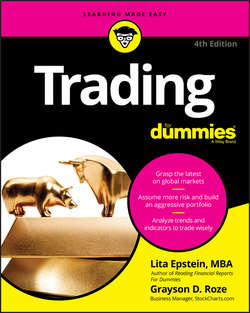Читать книгу Trading For Dummies - Lita Epstein - Страница 14
На сайте Литреса книга снята с продажи.
Part 1
Getting Started with Trading
Chapter 1
The Ups and Downs of Trading Stocks
Putting Trading Strategy into Practice
ОглавлениеAfter you get used to using the tools, you’re ready to put your new skills into practice making money. In Chapter 13, we show you how to put your newfound affinities for fundamental analysis and technical analysis together to develop and build your trading strategy. Using fundamental analysis, you can
❯❯ Determine which part of the economic cycle is driving the market.
❯❯ Determine which sector makes the most sense for stock trading.
❯❯ Figure out which sectors are in the best positions to go up.
❯❯ Find out which stocks are leading in the ascending sectors.
❯❯ Evaluate where the Fed stands on the economy and which potential moves by the Fed can impact the strength of the market.
❯❯ Evaluate and hopefully anticipate potential shocks to the market. Although doing so may seem like gazing into a crystal ball, you really can pick up some signs by checking out the key economic indicators. We show you what they are.
After you complete your fundamental analysis, we show you how to use your new technical analysis skills successfully. Using them, you find out how you can
❯❯ Trade within the overall technical conditions.
❯❯ Confirm which economic cycle a market is in by using index charts.
❯❯ Determine whether an ascending sector is stuck in a range or ready to enter a new upward trend.
❯❯ Determine whether leading stocks are stuck in ranges or ready to break out in upward trends.
Finally, we show you how to use your newfound skills to manage risk, set up a stop‐loss position, and choose your time frame for trading.
In Chapter 14, we introduce you to techniques for using exchange‐traded funds (ETFs) to ride the trends instead of taking the risk of finding just the right company in each sector. Sector ETFs have become a major trading tool for position traders who want to take advantage of sector rotation, which we talk about in Chapter 5.
After honing your skills, you’re ready to start trading. So in Chapter 15, we focus on the actual mechanics of trading by
❯❯ Discussing how to enter or trade into a position.
❯❯ Explaining bid and ask prices.
❯❯ Discussing the risks of market orders.
❯❯ Explaining how to use limit and stop orders.
We also explore how to exit or trade out of a position and still stay unattached emotionally, when to take your profits, and how to minimize your losses, in addition to discussing potential tax hits and how to minimize them.
Now that you know how to research the fundamentals, effectively use the technical tools, and mechanically carry out a trade, the next step is developing and managing your own trading system, which we discuss in Chapter 16. We explore the basic steps to developing the system, which include
1. Designing and keeping a trading log.
2. Identifying reliable trading patterns.
3. Developing an exit strategy.
4. Determining whether you’ll use discretionary trading methods or mechanical trading. We explore the pros and cons of each.
5. Deciding whether to develop your own trading system or buy one off the shelf.
6. Testing your trading systems and understanding their limitations before making a major financial commitment to your new system.
We also discuss assessing your results and fixing any problems.
After you’ve designed, built, and tested your system, you’re ready to jump in with both feet. The key to getting started: Make sure you begin with a small sum of money, examining your system and then increasing your trading activity as you gain experience and develop confidence with the system that you develop.
